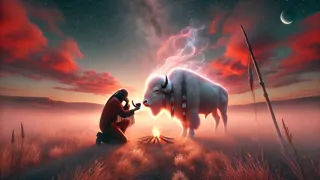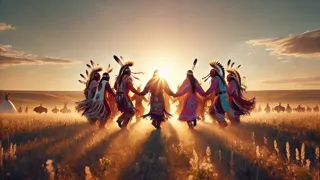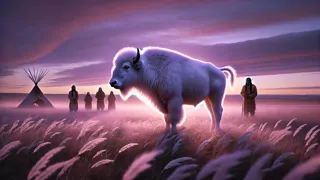Introduction
Under the boundless sky of the Great Plains, where wind sweeps across rolling seas of grass and earth, the Lakota people saw omens in subtle signs of nature. At twilight, when the sun tiptoes beneath distant clouds, a solitary white buffalo calf materialized at the edge of the horizon, its coat glowing like moonlit snow against the ochre plains. High among ancient hills and valleys etched with generations of footsteps, the calf stood silent and serene, inviting the people forward with quiet dignity. Elders gathered to witness this sacred vision, heartbeats racing in unison as they recognized the whispers of prophecy carried on the breeze. In that moment, the world held its breath, for the white buffalo was a bearer of divine presence, a living messenger bridging earth and spirit. Legends would call her the White Buffalo Woman, for she walked lightly upon the land, her hooves leaving trails of soft light in the twilight grass. She came to teach them to honor the four directions, to embrace ceremony, and to regard every being as kin in a vast tapestry of life. By offering the sacred pipe, she bound their hearts in unity and opened the way for prayers to ascend like smoke to the heavens. From the first faint rustle of her arrival to the memory that blooms in every heart, her teachings remain etched into the soul of the people, a timeless legacy of compassion and reciprocity. As generations pass and the world around them shifts, the enduring myth of the White Buffalo Woman reminds all who listen that the spirit of the land is alive, breathing through every river, stone, and gust of wind.
The Arrival of the White Buffalo Woman
Long before the tribes gathered in council under the shade of towering cottonwood trees, the earth itself seemed to whisper of a change to come. One evening, as the sun dipped behind distant buttes and the horizon blazed with a fiery procession of reds and golds, a lone hunter named Mato Whitebear followed the call of a drumbeat he could not hear. Drawn by an unspoken invitation, he crossed the undulating dunes of grass until he found himself face to face with a creature of impossible beauty—a white buffalo calf, its coat luminous beneath the last rays of dusk. Mato knelt, heart stilled by awe, and watched as the calf’s form began to rise, unfolding into the radiant figure of a woman draped in robes stitched with sacred symbols. She held a bundle of white sage, sweet grass, and tobacco, and in her hands rested a bundle wrapped in soft buckskin.

"People of Lakota," she spoke in a voice that trembled like an autumn breeze through the northern pines. "I am your sister and your guide. I come bearing a gift to unite my children in prayer and respect for all living things." At her words, Mato bowed his head as tears glimmered at his eyes, and he felt a pulse of warmth ripple through his chest. If the plains had a heartbeat, it would have been that very moment, as though the buffalo grass, the ancient hills, and the sky itself echoed in joyous response.
She offered him the gift: a sacred pipe crafted from red pipestone, its stem carved from a single branch of cherry wood. "This pipe will carry your prayers to the Creator," she explained, lighting the bowl with embers that glowed like a captured star. "Through each offering, you will remember that life is woven from four directions, carried on four winds, and sacred in heart, body, mind, and spirit." Mato accepted the pipe with reverence, feeling its weight both physical and numinous. As the first curl of fragrant smoke rose toward the heavens, the woman blessed the people’s future ceremonies—births, hunts, marriages, farewells—binding every generation to a covenant of harmony. Then, as quietly as she had arrived, she retreated beyond the horizon, leaving behind the sacred bundle and a promise that her spirit would walk among her people whenever they honored the pipe in faith and humility.
The Gift of the Sacred Pipe
Across rivers and valleys, from campfire to council lodge, word of the White Buffalo Woman’s arrival rippled through Lakota nation. People traveled on horseback and on foot, drawn by dreams and visions that carried the echo of her voice. When they gathered, the sacred pipe was placed in the center of the circle—an emblem of trust and unity. The elders spoke of the colors of the pipe’s stem, each chosen with care: red for the earth, yellow for the sun, black for the night sky, and white for the buffalo woman’s blessing. With each offering of tobacco, the smoke spiraled upward, dissolving boundaries between worlds and binding hearts within a single prayer. Mothers pressed their infants close, teaching them the first words of gratitude; warriors held the pipe before each hunt, seeking compassion for the creatures they would honor. In marriages, the bride and groom shared a sacred puff, promising fidelity not only to each other but to the balance of life itself.

Song and dance became the vessels for her teachings. Young people learned the pipe songs under a canopy of stars, voices rising in harmonious gratitude. Drums reverberated like distant thunder, echoing the heartbeat of the buffalo and calling the winds to bear their pleas. The women prepared the sacred meals—corn, beans, and squash—offered in thanks for the harvest and the cycles of renewal. Children, with faces painted in the four sacred colors, grew up knowing that every ripple in a stream and every pattern traced by bird flight was part of a single great vision.
When disagreements arose between bands or when a harsh winter tested their resilience, the pipe circle offered reconciliation. Leaders laid down weapons and laid hands alongside hopes, old grievances fading like footprints in the morning dew. In smoke and ceremony, the White Buffalo Woman’s promise endured, guiding hearts back to the wisdom of reciprocity. Each ritual was a thread woven into a tapestry of memory, ensuring that love for the land and compassion for one another would stand firm across generations.
A Covenant of Harmony
Time moved like a river, carving canyons through rock and memory alike. Yet the covenant of the White Buffalo Woman lived on in the stories elders told around crackling fires and in the prayers woven into everyday life. Traders and travelers spoke of a people united in ceremony, guided by a spirit that walked beside them. When settlers arrived on the horizon, tensions flared as new laws and claims challenged ancestral ties to the land. But even then, the sacred pipe was laid on treaty bundles, its smoke a reminder that promises carry weight beyond ink on paper. Chiefs and councilors invoked her teachings to shape councils of peace, insisting that respect for earth and sky remained nonnegotiable.

In times of drought, when rivers shrank and the grass turned brittle, medicine men and women called on the old songs. They called the four directions. They sang of the white buffalo and watched the sky for signs of renewal. When the first snow fell—pure and silent—they remembered the calf’s coat and sang thanks rather than lament loss. For they knew that adversity tested commitment, and that through ceremony and sacrifice, balance could return.
Today, across rolling reservations and urban centers alike, communities gather in sweat lodges and round dances, renewing the promises sealed by the White Buffalo Woman. Young activists lead marches to protect water and sacred sites, carrying effigies of the white buffalo in their hearts. Elders smile as they witness a resurgence of interest in language, song, and the four sacred directions. The covenant remains alive—an unbroken circle of hope and humility. In every offering of tobacco, every grain of corn planted with prayer, and every silent vow to protect the land, her spirit dances softly at the edge of the firelight, reminding all who listen that harmony is both gift and responsibility.
Conclusion
Beneath the vast canopy of stars that blankets the Great Plains, the story of the White Buffalo Woman endures as both promise and guide. Her teachings—gifted through the sacred pipe and woven into every prayer and ceremony—remind us that we are never separate from the earth, its creatures, and one another. In honoring the four directions, we nurture the harmony that sustains every living being. When we offer our tobacco, dance around the fire, or simply whisper gratitude to the sky, we awaken a timeless covenant that unites heart and spirit across centuries. Let her legacy inspire each of us to walk gently upon the land, to protect water and wildlife, and to listen for the silent song carried on the wind. For as long as the white buffalo’s spirit rides the horizon, hope blooms anew in the hearts of those who remember her promise of balance, respect, and enduring grace.

















